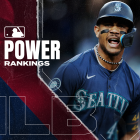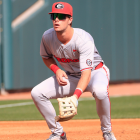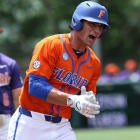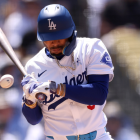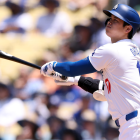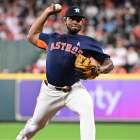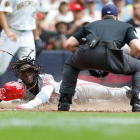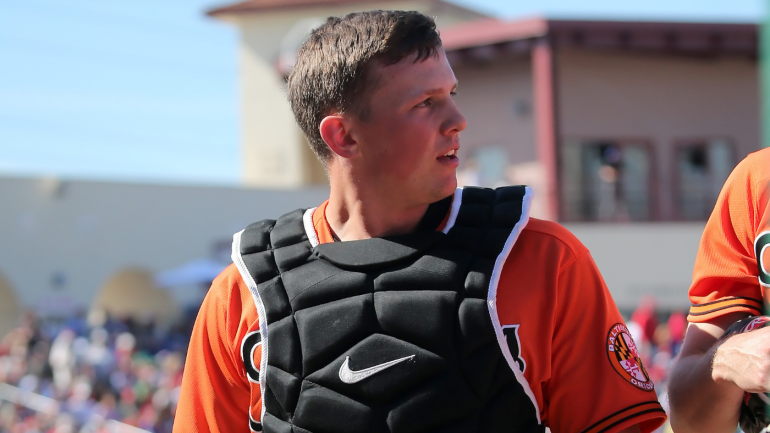
The theme of Major League Baseball's season so far has been the lack of offense. Coming into play on Thursday, the league-average slash line was just .236/.312/.395. Teams are striking out more frequently than ever before, hitting for the lowest average in league history, and plating runs at a lower clip than they have since the 2015 season.
Unfortunately, it doesn't appear that some of the game's most promising minor leaguers are immune to the offensive impotency. There have been 38 position players selected in the top 30 of either of the last two drafts. Entering this week, 11 of those players had an OPS below .700.
Of course, there is a reasonable explanation for why minor-league players might be having a rough go at it. The pandemic wiped out last year's minor-league season, meaning these players haven't before experienced a normal year. Add in how the 2021 season -- which began in early May -- remains in the "small-sample size" bin, and it's not too surprising that some recent draftees are posting ugly stat lines.

Fantasy Baseball Today Newsletter
Your Cheat Code To Fantasy Baseball
You're destined to gain an edge over your friends with advice from the award-winning FBT crew.
Thanks for signing up!
Keep an eye on your inbox.
Sorry!
There was an error processing your subscription.
Still, for the sake of content, we decided to highlight three recent first-round picks who are doing well, and three who are hoping for sunnier days ahead.
The Good
Adley Rutschman, C, Baltimore Orioles
The top pick in the 2019 draft, Rutschman has been phenomenal so far this season. In 110 plate appearances with the Bowie Baysox (Double-A), he's hitting .277/.445/.530 with six home runs and two more walks than strikeouts (23 versus 21). When the Baysox played a doubleheader on Sunday, Rutschman started both games and he combined to go 5 for 6 with two home runs, seven runs batted in, and a walk. He's the best catching prospect in the game for a reason, and that reason is he has the potential to become a multiple-time All-Star once he reaches the Show.
CJ Abrams, SS, San Diego Padres
Abrams was the sixth pick and the sixth position player to come off the board in that 2019 class. He's hitting .288/.366/.438 with two home runs and four stolen bases (on four attempts) in 19 games at the Double-A level. Those numbers may not pop off the page like Rutschman's do, but the context surrounding his performance is important. Abrams, who won't turn 21 until after the season, is playing against competition that is four years his senior. The average slash line in his league is .232/.327/.371, while his San Antonio team is hitting .229/.314/.346. Oh, and Abrams entered the year with fewer than 10 career at-bats above rookie ball. When you consider those angles, what he's doing is borderline remarkable -- and bodes well for him turning into a star.
Jordan Walker, 3B, St. Louis Cardinals
You can excuse any Cardinals fan who feels like they're experiencing déjà vu. Back in 2018, the Cardinals drafted a power-hitting third baseman (Nolan Gorman) with the 19th pick who then dominated the competition in his first professional season. Last summer, the Cardinals popped a similar prospect, in Walker, with the 21st pick. He's following Gorman's blueprint for raising one's stock by hitting .333/.474/.600 with seven extra-base hits in 45 at-bats against Low-A competition. Walker leads the league in both average exit velocity (94.7 mph) and max exit velocity (116), with the latter putting him in rarified air. (Only seven big-league players have hit a ball harder than he has this season.) Walker will need to learn to lift the ball more consistently, as his average launch angle is around 2 degrees. If he can make that adjustment (and he just turned 19), then he's going to assert himself as one of the top slugging prospects in the minors.
The Not-So-Good
Aaron Sabato, 1B, Minnesota Twins
It's always risky to take a right-handed hitting, right-handed throwing first baseman in the top-30. The Twins decided Sabato was worth the gamble at No. 27 based on his performance (.332/.435/.601 with big exit velocities to boot) in parts of two seasons at North Carolina. Alas, he hasn't found his groove yet in pro ball. Instead, Sabato is hitting .159/.357/.273 with an 88.9-mph average exit velocity and strikeouts in 36.5 percent of his 115 plate appearances against Low-A competition that is, on average, six months younger than him. There's no sense in panicking just yet, but it's fair to write that isn't what you want from a player so dependent on his bat.
Patrick Bailey, C, San Francisco Giants
Bailey, the 13th pick last June, doubled as the first catcher to come off the board. We noted at the time that "while he's skilled at working deep counts and punishing mistakes," he was "a candidate to finish with a below-average hit tool due in part to his tendency to whiff." You can guess where this is going, so let's get to the point: Bailey is hitting .229/.308/.375 with a 30.8 percent strikeout rate in his first 107 plate appearances against High-A competition. He has stolen six bases already, however, by taking advantage of the league's rule changes.
Logan Davidson, SS, Oakland Athletics
Double-A is essentially the page-69 test for prospects: if you like what you're seeing there, you'll probably be on board with what comes next. At least in one sense, the A's are probably eager to turn the page based on how Davidson, the 29th pick in 2019, has performed in his first 113 plate appearances at the level: .167/.286/.250 with a 24.8 percent strikeout rate. His profile hinges on him hitting for power to counterbalance his strikeout proneness, so it's not an encouraging sign that his career slugging percentage is .306 after his first 351 professional plate appearances.














